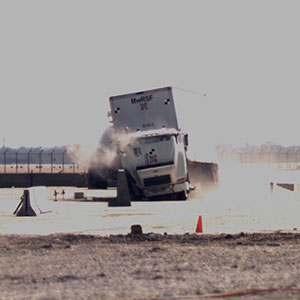Calendar Icon
Apr 20, 2016
Person Bust Icon
By Karl Vogel
![]() RSS
Submit a Story
RSS
Submit a Story

UNL's Midwest Roadside Safety Facility spent nearly seven months setting up a test of a concrete roadside barrier at the Lincoln Air Park testing facility.
In a matter of seconds on a windy afternoon, it was over. But it's possible the lasting impact of the April 13 test will be felt for years to come.
MwRSF, in a collaboration with Manitoba Infrastructure and Transportation, had designed a 49-inch, single-slope concrete roadside barrier to help lessen the damage to vehicles and passengers in crashes.
To test the barrier, an 80,000-pound tractor trailer was placed on steel cables and pulled by two pickup trucks until it reached an optimum speed of 50 miles per hour. Then, it was released and guided along a path until it collided at a 15-degree angle with the concrete barrier and had its momentum stopped by a remote-controlled braking system.
With a crowd of interested spectators – including Nebraska Gov. Pete Ricketts and officials from both the Nebraska Department of Roads and Manitoba Infrastructure and Transportation – inspecting the aftermath, MwRSF director Ron Faller declared the test a smashing success.
Jennifer Schmidt, research assistant professor at MwRSF, was also excited about the early results.
Despite a few small cracks in the concrete barrier, there was little damage done to the barrier structure. A steel plate designed by the MwRSF team to span the gap between bridge sections not only stayed in place but sustained only a few marks from the truck's tires and lugnuts.
The truck's engine was destroyed by the impact with the barrier, but the passenger cab remained intact. Schmidt said she was especially pleased that the entire vehicle remained upright throughout the test, especially with the wind gusting to nearly 35 miles per hour.
"That was great. That was awesome to see," Schmidt said. "We expected, maybe, a little more damage, but the truck remained upright after the impact, which doesn't even need to happen. As long as it doesn't get behind there (the barrier) that's great. With the very little damage we saw, that was very awesome."
Because of this successful test, Schmidt said highways in the U.S. and Canada could soon have this barrier, which was modified from a California Department of Transportation design.
Schmidt said officials from Manitoba will consider whether to install the barriers on highways in that Canadian province and the MwRSF will submit results from this test and await approval for the barrier from the U.S. Federal Highway Administration. That approval could lead to American states choosing to use these barriers and receive federal reimbursement of some construction costs.
"Manitoba wants this to be their standard barrier, and they seem very open to having our states use it as well," Schmidt said.
In a matter of seconds on a windy afternoon, it was over. But it's possible the lasting impact of the April 13 test will be felt for years to come.
MwRSF, in a collaboration with Manitoba Infrastructure and Transportation, had designed a 49-inch, single-slope concrete roadside barrier to help lessen the damage to vehicles and passengers in crashes.
To test the barrier, an 80,000-pound tractor trailer was placed on steel cables and pulled by two pickup trucks until it reached an optimum speed of 50 miles per hour. Then, it was released and guided along a path until it collided at a 15-degree angle with the concrete barrier and had its momentum stopped by a remote-controlled braking system.
With a crowd of interested spectators – including Nebraska Gov. Pete Ricketts and officials from both the Nebraska Department of Roads and Manitoba Infrastructure and Transportation – inspecting the aftermath, MwRSF director Ron Faller declared the test a smashing success.
Jennifer Schmidt, research assistant professor at MwRSF, was also excited about the early results.
Despite a few small cracks in the concrete barrier, there was little damage done to the barrier structure. A steel plate designed by the MwRSF team to span the gap between bridge sections not only stayed in place but sustained only a few marks from the truck's tires and lugnuts.
The truck's engine was destroyed by the impact with the barrier, but the passenger cab remained intact. Schmidt said she was especially pleased that the entire vehicle remained upright throughout the test, especially with the wind gusting to nearly 35 miles per hour.
"That was great. That was awesome to see," Schmidt said. "We expected, maybe, a little more damage, but the truck remained upright after the impact, which doesn't even need to happen. As long as it doesn't get behind there (the barrier) that's great. With the very little damage we saw, that was very awesome."
Because of this successful test, Schmidt said highways in the U.S. and Canada could soon have this barrier, which was modified from a California Department of Transportation design.
Schmidt said officials from Manitoba will consider whether to install the barriers on highways in that Canadian province and the MwRSF will submit results from this test and await approval for the barrier from the U.S. Federal Highway Administration. That approval could lead to American states choosing to use these barriers and receive federal reimbursement of some construction costs.
"Manitoba wants this to be their standard barrier, and they seem very open to having our states use it as well," Schmidt said.
Submit a Story





